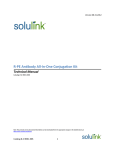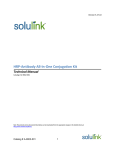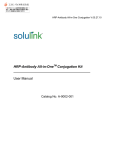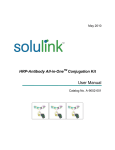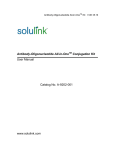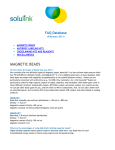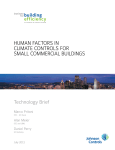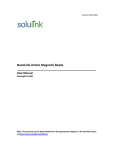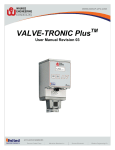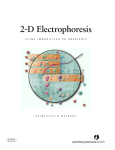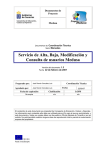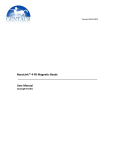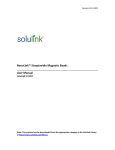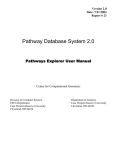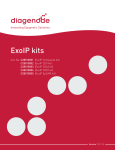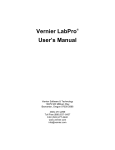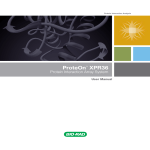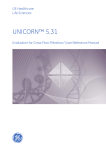Download Technical manual
Transcript
Version 6.01.10 HRP-Antibody All-In-One Large Scale Conjugation Kit Technical Manual Catalog # A-9302-001 Note: This protocol and any documents linked below can be downloaded from the appropriate category in the Solulink Library at http://www.solulink.com/library. Catalog # A-9302-001 1 Disclaimer The products offered here are for research use only. Any commercial application will require a license from Solulink. The Solulink Conjugation System is patented and has multiple patents pending. Please contact Solulink for information regarding licensing information. Solulink products and methods may be covered by one or more of the following United States patents Nos. 6,686,461, 6,800,728, 7,102,024, 7,173,125, 7,462,689 and other pending patent applications. Information in this manual is subject to change without notice and does not constitute a commitment on the part of Solulink, Inc. It is supplied on an “as is” basis without any warranty of any kind, either explicit or implied. Information may be changed or updated in this manual at any time. This document may not be copied, transferred, reproduced, disclosed, or duplicated, in whole or in part, without the prior written consent of Solulink, Inc. This documentation is proprietary information and protected by the copyright laws of the United States and international treaties. The manufacturer of this documentation is Solulink, Inc Safety Information WARNING – CHEMICAL HAZARD. Some chemicals used can be potentially hazardous, and can cause injury or illness. • Read and understand the Material Safety Data Sheets (MSDS) available at Solulink.com before you store, handle, or work with any chemicals or hazardous materials. • Minimize contact with and inhalation of chemicals. Wear appropriate personal protective equipment when handling chemicals (e.g. safety glasses, gloves, or clothing). For additional safety guidelines consult the MSDS. • Check regularly for chemical leaks or spills. If a leak or spill occurs, follow the manufacturer’s clean-up procedures as recommended in the MSDS. • Comply with all local, state/provincial, or national laws and regulations related to chemical storage, handling and disposal. Catalog # A-9302-001 2 Table of Contents Chapter 1: Introduction......................................................................................................................4 a. User Manual.................................................................................................................................. 4 b. Purpose of Manual........................................................................................................................ 4 c. Intended Users ............................................................................................................................. 4 d. Customer Service and Technical Support ..................................................................................... 4 Chapter 2: Overview of Conjugation ...................................................................................................5 a. Product Description ...................................................................................................................... 5 b. All-in-One Technology................................................................................................................... 5 c. All-in-One Conjugation Process Summary..................................................................................... 8 d. Materials Provided and Storage Conditions ................................................................................. 9 e. Additional Materials Required But Not Provided ......................................................................... 9 Chapter 3: Antibody-HRP All-in-One Conjugation Protocol ................................................................10 a. IgG Sample Preparation .............................................................................................................. 10 b. Buffer Exchange IgG.................................................................................................................... 10 c. HyNic Modify IgG......................................................................................................................... 11 d. Buffer Exchange IgG.................................................................................................................... 12 e. Conjugate Formation .................................................................................................................. 13 f. Buffer Exchange Conjugate ......................................................................................................... 13 g. Q Spin Filter Purification ............................................................................................................. 14 h. Buffer Exchange Purified Conjugate ........................................................................................... 15 Chapter 4: Appendix ........................................................................................................................17 a. Monoclonal IgG-HRP Conjugate: An Example............................................................................ 17 b. Direct ELISA Assay Using IgG-HRP All-in-One Conjugate ............................................................ 18 c. Bradford Protein Assay................................................................................................................ 19 d. Using a NanoDropTM to Measure Antibody Concentration ........................................................ 21 e. HRP Absorption Spectrum (Unmodified Horseradish peroxidase)............................................. 23 f. 4FB-modified HRP Absorption Spectrum .................................................................................... 23 g. Bovine IgG-HRP Conjugate Absorption Spectrum (All-in-One Purified) ..................................... 24 h. Concentration of Dilute Antibody Solutions ............................................................................... 24 i. Troubleshooting Guide................................................................................................................. 26 j. Component Stability on Storage ................................................................................................. 27 k. References................................................................................................................................... 28 Catalog # A-9302-001 3 Chapter 1: Introduction a. User Manual This manual provides instructions for using the HRP-Antibody All-in-One Large Scale Conjugation Kit. This chapter contains the following sections: Purpose of Manual Intended Users Customer Service and Technical Support b. Purpose of Manual The purpose of this manual is to provide the user with the necessary instructions and reagents to produce one (1) HRP-antibody conjugate. Use of the kit results in: The modification of a user-supplied IgG antibody (5 milligrams) using S-HyNic linker. The conjugation of HyNic-modified IgG with 4FB-HRP resulting in formation of an HRPantibody conjugate. Spin filter isolation of highly purified IgG-HRP conjugate; yielding approximately 4.5 milligrams of material free of residual enzyme and antibody. c. Intended Users The HRP-Antibody All-in-One Kit is designed for users with minimal or no conjugation experience allowing them to prepare customized, high purity, ready-to-use HRP-antibody conjugates within a single day. d. Customer Service and Technical Support Additional technical information can be found at: Telephone Email 1-888-625-0670 (Toll Free) [email protected] Fax Address 1-858-625-0770 Solulink-The Conjugation Company 9853 Pacific Heights Blvd, Ste H San Diego, CA 92121 Catalog # A-9302-001 4 Chapter 2: Overview of Conjugation a. Product Description Each HRP-Antibody All-in-One Conjugation Kit provides all the necessary components to produce one (1) highly purified HRP-IgG conjugate. The kit requires a user to provide 5 milligrams of starting IgG antibody. Any suitably purified monoclonal or polyclonal antibody regardless of species origin or IgG subclass can be conjugated and purified within 5 hours (60 minutes hands-on). The components of this kit feature a stable, high-activity, preactivated horseradish peroxidase (>250U/mg) and a novel Q spin filter that delivers purified conjugate in high yield (approx. 4.5 mg). Conjugates are > 95% pure, free of both residual antibody and un-conjugated HRP. Conjugates produced are guaranteed to provide optimum signal to noise in sensitive downstream applications. All-in-One conjugation kits are based on Solulink’s patented HydraLinkTM chemistry. This chemistry relies on a specific reaction between an aromatic hydrazine (HyNic) and an aromatic aldehyde (4FB); leading to formation of a stable bis-arylhydrazone bond. HydraLinKTM conjugation chemistry is capable of efficiently converting nearly 100% of an antibody to its conjugate form. This efficiency is made possible through the recent discovery that aniline rapidly catalyzes hydrazone bond formation (1, 2, 3). Aniline’s ability to increase both the rate and efficiency of conjugate formation under mild reaction conditions yields reproducible and quantitative conversion of free antibody to conjugate. Complete conversion of conjugate greatly simplifies downstream purification. Conjugate purification consists of selectively binding conjugate to a novel Q spin filter membrane that allows excess HRP to flow through unbound. This spin filter provides high purity without sacrificing yield. Conjugates made with these kits are compatible with all downstream applications requiring high immunological specificity and sensitivity such as Westerns, ELISAs, or IHC. Finally, each kit yields between 4 and 5 mg of highly purified HRP-antibody conjugate. b. All-in-One Technology 1) Conjugation Chemistry HydraLinKTM chemistry is based on the use of two complementary heterobifunctional linkers; S-HyNic and Sulfo-S-4FB (Figure 1). S-HyNic (Succinimidly-6-hydrazinonicotinamide) is used to modify and incorporate protected aromatic hydrazines (HyNic groups) into the antibody via acylation of lysine residues. In a similar fashion a second linker known as Sulfo-S-4FB (Sulfo-N-succinimidly-4-formylbenzamide) is used at Solulink to form a pre-activated, high activity form of HRP called 4FB-HRP (provided in the kit). Incubation of HyNic-modified antibody with pre-activated 4FB-HRP in the presence of aniline catalyst Catalog # A-9302-001 5 leads to rapid and efficient conversion of antibody to conjugate through formation of stable bis-arylhydrazone bonds (Figure 2). Figure 1. Structure of S-HyNic and Sulfo-S-4FB linkers used in conjugating HRP to antibody. Figure 2. Aniline catalyzed formation of IgG-HRP conjugate. Catalog # A-9302-001 6 2) Conjugate Purification The efficiency of catalyzed hydrazone bond formation greatly simplifies conjugate purification. Because aniline increases both the rate and efficiency of conjugate formation under mild reaction conditions; it leads to near quantitative (>97%) conversion of free antibody to conjugate; leaving behind only excess 4FB-HRP. Purification then simply consists of selectively binding the conjugate to a novel filter (Q spin filter) that exploits biophysical properties of the antibody portion of the conjugate (4, 5) while permitting free HRP to flow through unbound. In this manner conjugate is eluted in highly purified form with high yield (4 to 5 milligrams). Figure 3. Q spin filter purification of HRP-IgG conjugates. Catalog # A-9302-001 7 c. All-in-One Conjugation Process Summary Figure 4. Summary of conjugation process. Catalog # A-9302-001 8 d. Materials Provided and Storage Conditions Components Amount S-HyNic 1 x 500 µg 4FB-Modified HRP Buffer A Buffer B Buffer C Buffer D PBS 5ml Spin Column Q Spin Filter Q Collection Tubes DMF Diafiltration Spin Filters 2 x 1.1 ml 5 ml 5 ml 30 ml 1 5 ml 5 1 2 0.5 ml 1 Storage conditions Keep refrigerated within desiccated sealed aluminum pouch Keep refrigerated (2-8oC) Keep refrigerated (2-8oC) Keep refrigerated (2-8oC) Keep refrigerated (2-8oC) Keep refrigerated (2-8oC) Keep refrigerated (2-8oC) Keep refrigerated (2-8oC) Room temperature or refrigerated Room temperature or refrigerated Room temperature or refrigerated Room temperature or refrigerated e. Additional Materials Required But Not Provided Bradford Protein Assay Reagents (verification of final conjugate concentration) Standard UV-VIS or NanoDropTM Spectrophotometer Pipettes (P-10, P-100, P-1000) and tips Table Top Centrifuge (e.g. variable speed capable of handling 15 and 50 ml disposable tubes) 1.5 microfuge tubes, 15 and 50 ml disposable tubes Catalog # A-9302-001 9 Chapter 3: Antibody-HRP All-in-One Conjugation Protocol a. IgG Sample Preparation Antibodies come in two physical forms, solids or liquids. Individual samples can vary significantly in the amount of packaged IgG (protein mass) and/or concentration (mg/ml). We highly recommend that IgG concentrations be confirmed either by a Bradford protein assay or A280 whenever possible. The All-in-One conjugation protocol requires that antibody samples be free of protein carriers such as BSA or gelatin before proceeding. A 5 milligram quantity of antibody is required to start the procedure. Depending on the state of your initial sample (solid or liquid), proceed as follows: Antibody is in Solid Form (e.g. lyophilized powder) Resuspend the lyophilized antibody (5 mg free of protein additives gelatin or BSA) in 1.25 ml Buffer A to obtain a 4 mg/ml solution. If the antibody sample contains less than 5 mg per vial (e.g. 1 mg), resuspend the requisite number of vials equivalent to 5 mg in 1.25 ml Buffer A to obtain a 4 mg/ml solution. Proceed to step b. Antibody is in Liquid Form (e.g. PBS or TBS Buffer) If an antibody sample is in liquid form at 4 mg/ml, simply transfer 1.25 ml to a labeled microfuge tube (5 mg). If the sample is in liquid form at a concentration greater than 4 mg/ml, transfer a volume equivalent to 5 mg antibody to a labeled microfuge tube and add Buffer A to obtain a 4 mg/ml solution. If a sample is at a concentration less than 4 mg/ml, concentrate the sample to 1.25 ml and 4 mg/ml using any suitable ultrafiltration spin filter (e.g. Amicon or VivaSpin) as described in the Appendix. A concentration filter is provided with this kit. Proceed to step b. b. Buffer Exchange IgG 1. Prepare a 5 ml spin column (provided) by twisting off the bottom closure and loosening the cap (do not remove). Place the spin column into a 15 ml collection tube (not provided). 2. Mark the top of the cap using an indelible pen to identify the sample and place a vertical mark on the side of each spin column as illustrated on the next page. Catalog # A-9302-001 10 5 ml spin column and 15 ml collection tube 3. Place the assembly into the table top centrifuge and orient the vertical mark on the spin column aiming outward and away from the center of the rotor. 4. Centrifuge at 1,000 x g for 2 minute. Discard the flow through from the collection tube. The column matrix will appear white in color. Place the column back into the empty 15 ml collection tube. 5. Add 2.5 ml of Buffer A to the top of dry resin bed. Centrifuge at 1,000 x g for 2 minutes. Discard the flow through from the collection tube. 6. Repeat step 5 two (2) additional times. Place the column back into a new empty 15 ml collection tube (not provided). 7. Remove the cap; load the antibody sample (1.25 ml at 4 mg/ml) to the top of the dry resin bed; loosely recap and place the column back into the collection tube. 8. Orient the spin column mark outward as before and centrifuge at 1,000 x g for 2 minutes. Use an appropriate balance tube opposite the assembly. IMPORTANT: rotor speed should be set to 1000 x g (RCF) and not 1000 x rpm (RPM). The volume recovered should always be approximately the same volume that was loaded on the spin column (e.g. 1.25 + 0.2 ml). If the recovered volume is low, the centrifuge may require recalibration. If volume is low; re-centrifuge at the appropriate speed in an attempt to recover the full volume (i.e. 1.25 ml). 9. Cap and label the 15 ml collection tube containing buffer exchanged antibody. c. HyNic Modify IgG 1. Add 100 µl DMF to S-HyNic reagent vial. Pipette the solution up and down to resuspend the reagent pellet. Catalog # A-9302-001 11 2. Add 58 µl dissolved S-HyNic reagent to the antibody solution (1.25 ml @ 4mg/ml). Pipette the solution up and down to mix. 3. Incubate the reaction for 2 h at room temperature. Set the mixture in a dark place or cover with aluminum foil. d. Buffer Exchange IgG 1. Ten minutes before the end of the IgG modification reaction prepare a 5 ml spin column (provided) by twisting off the bottom closure and loosening the cap (do not remove). Place the spin column into a 15 ml collection tube (not provided). 2. Mark the top of the cap using an indelible pen to identify the sample and place a vertical mark on the side of each spin column as shown below. 5 ml spin column and 15 ml collection tube 3. Place the assembly into the table top centrifuge and orient the vertical mark on the spin column aiming outward and away from the center of the rotor. 4. Centrifuge at 1,000 x g for 2 minute. Discard the flow through from the collection tube. The column matrix will appear white in color. Place the column back into the same empty 15 ml collection tube. 5. Add 2.5 ml of Buffer B to the top of dry resin bed. Centrifuge at 1,000 x g for 2 minute. Discard the flow through from the collection tube. 6. Repeat step 5 two (2) additional times. Place the column back into a new empty 15 ml collection tube (not provided). Catalog # A-9302-001 12 7. Remove the cap; load the entire antibody/HyNic modification reaction (~1.25 ml at 4 mg/ml) to the top of the dry resin bed; loosely recap and place the column back into the collection tube. 8. Orient the spin column mark outward as before and centrifuge at 1,000 x g for 2 minutes. Use an appropriate balance tube opposite the assembly. 9. Cap and label the 15 ml collection tube containing the buffer exchanged antibody. e. Conjugate Formation 1. Spin two dark brown vials containing 4FB-modified HRP (5 seconds @ 1000 x g) to collect the contents at the bottom of each tube. 2. Transfer the two 1.1 ml 4FB-modified HRP aliquots to the tube containing HyNicmodified antibody (1.25 ml); pipette the mixture (~3.5 ml) up and down to mix. Set the reaction mixture in a dark place or cover with aluminum foil. 3. Incubate for 2 h at room temperature. f. Buffer Exchange Conjugate 1. Ten minutes prior to the end of the conjugation reaction prepare two 5 ml spin columns (provided) by twisting off the bottom closure and loosening the cap (do not remove). Place the spin columns into new 15 ml collection tubes (not provided). 2. Mark the top of the cap using an indelible pen to identify the sample and place a vertical mark on the side of each spin column as shown below. 5 ml spin column and 15 ml collection tube 3. Place the two assemblies into a table top centrifuge and orient the vertical mark on the spin columns aiming outward and away from the center of the rotor. Catalog # A-9302-001 13 4. Centrifuge at 1,000 x g for 2 minute. Discard the flow through from each collection tube. The column matrix will appear white in color. Place the columns back into the same empty 15 ml collection tubes. 5. Add 2.5 ml of Buffer C to the top of each dry resin bed. Centrifuge at 1,000 x g for 2 minutes. Discard the flow through from each the collection tube. 6. Repeat step 5 two (2) additional times. Place the column back into a new empty 15 ml collection tube (not provided). 7. Remove the caps; load 1.75 ml conjugate onto each spin column (Section e, step 3) to the top of the dry resin bed; loosely recap and place the columns back into their collection tubes. 8. Orient the spin column mark outward as before and centrifuge at 1,000 x g for 2 minutes. 9. After centrifugation, add 3.5 ml Buffer C to the bottom of each collection tube containing the conjugate (~5.25 ml volume in each collection tube) and pipette up and down to mix. Set both collection tubes aside containing the conjugate in a dark place or cover with aluminum foil. g. Q Spin Filter Purification 1. Pre-wet a Q spin filter by adding 1.5 ml Buffer C to the top of the unit (see filter below) and incubate for 2 minutes. 2. Place the spin filter assembly into a table top centrifuge and orient the letter Q towards the center of the rotor; spin at 500 x g for 4 minutes; discard the flowthrough and place the filter back into the empty collection tube. 3. Load one-half of the antibody-HRP conjugate volume (~5.25 ml, section f step 9) to the top of the filter unit and incubate for 2 minutes. 4. Place the oriented and balanced assembly in the table top centrifuge and spin at 500 x g for 4 minutes. Catalog # A-9302-001 14 5. Load the second half of the antibody-HRP conjugate volume (~5.25 ml, section f, step 9) to the top of the same filter unit and incubate for 2 minutes. 6. Place the oriented assembly in the centrifuge and spin at 500 x g for 4 minutes; discard the flow-through from the collection tube and place the Q spin filter back into the same empty collection tube. Note- a brown colored conjugate will be visible on the top of the Q membrane. 7. Add 5 ml Buffer C to the filter unit; orient in the table top centrifuge and spin at 500 x g for 4 minutes; discard the flow-through from the bottom collection tube and place the filter back into the same empty collection tube. 8. Repeat step 7 three (3) additional times. 9. Remove the Q spin filter unit from its collection tube and place it into a new collection tube (provided). 10. Add 0.5 ml Buffer D to the top of the Q spin filter containing the tightly bound brown conjugate and incubate for 5 minutes on the bench top. 11. Place the oriented and balanced assembly in a table top centrifuge and spin at 500 x g for 4 minutes to elute. 12. Repeat step 10 and 11 two (2) additional times. Total elution volume will be 1.5 ml. Set the collection tube aside on the bench. h. Buffer Exchange Purified Conjugate 1. Prepare a 5 ml spin column (provided) by twisting off the bottom closure and loosening the cap (do not remove). Place the spin column into a 15 ml collection tube (not provided). 2. Mark the top of the cap using an indelible pen to identify the sample and place a vertical mark on the side of the spin column as shown below. 5 ml spin column and 15 ml collection tube Catalog # A-9302-001 15 3. Place the balanced assembly into a table top centrifuge and orient the vertical mark on the spin column aiming outward and away from the center of the rotor. 4. Centrifuge at 1,000 x g for 2 minute. Discard the flow through from the collection tube. The column matrix will appear white in color. Place the column back into the same empty 15 ml collection tube. 5. Add 2.5 ml of PBS buffer to the top of dry resin bed. Centrifuge at 1,000 x g for 2 minute. Discard the flow through from the collection tube. 6. Repeat step 5 two (2) additional times. 7. Place the spin column into a new 15 ml collection tube (not provided). 8. Remove the cap; load 1.5 ml eluted conjugate (Section g, step 12) to the top of the dry resin bed; loosely recap and place the column back into the collection tube. 9. Orient the spin column mark outward as before and centrifuge at 1,000 x g for 2 minutes. Use an appropriate balance tube opposite the assembly. 10. After centrifugation, transfer the purified conjugate solution (1.5 ml) from the bottom of the collection tube to a new 1.5 ml tube and label appropriately. 11. Measure the final conjugate protein concentration using a Bradford or BCA protein assay (see Appendix). Catalog # A-9302-001 16 Chapter 4: Appendix a. Monoclonal IgG-HRP Conjugate: An Example Figure 5. Coomassie-stained (4-12% SDS-PAGE) gels illustrating typical conjugation results. Horseradish peroxidase is a 44 kD highly glycosylated protein that migrates as a broad, high M.W. band when the protein sample is not heated (70oC) before loading on the SDS-PAGE gel. Lane 1. Protein M.W. Marker Lane 2. 4FB-HRP (1x LDS sample buffer, unheated sample 7.5 µg) Lane 3. 4FB-HRP (1x LDS sample buffer, heat-treated 70oC 4 min 7.5 µg) Lane 4. GK1.5 mAb (1x LDS sample buffer, unheated sample 1.5 µg) Lane 5. GK1.5 mAb (1x LDS sample buffer, heat-treated 70oC 4 min 1.5 µg) Lane 6. GK1.5 /HRP crude conjugation rxn (1x LDS sample buffer, unheated sample 7.5 µg) Lane 7. GK1.5 /HRP purified conjugate (1x LDS sample buffer, unheated sample) Lane 8. GK1.5 /HRP purified conjugate (1x LDS sample buffer, heat-treated 70oC 4 min) Lane 9. GK1.5 /HRP Q filter 1st flow-through 20 µL (1x LDS sample buffer, unheated sample) Lane 10. GK1.5 /HRP Q filter 1st flow-through 20 µL (1x LDS sample buffer, heat-treated 70oC 4 min) Catalog # A-9302-001 17 b. Direct ELISA Assay Using IgG-HRP All-in-One Conjugate Figure 6. Direct ELISA curves generated using an HRP conjugate made with the All-in-One kit. A mouse anti-FITC monoclonal antibody was conjugated to HRP as described in the manual. Antigen consisting of FITC-labeled BSA (FITC MSR = 2) was coated on plates in a 2-fold dilution series (100 µl @ 500, 250, 125, 62.5, 31.25, 15.625, 7.8, 3.90, and 1.95 ng/ml) using standard methods. Immobilized antigen was then detected at 3 different conjugate concentrations (1 µg/ml. 0.5 µg/ml. 0.25 µg/ml) using TMB substrate (20 minutes @ 450 nm) on a Molecular Devices plate reader. Catalog # A-9302-001 18 c. Bradford Protein Assay Solulink highly recommends that whenever IgG is not limiting or its concentration, source, or quality are unknown that the sample be assayed for initial protein concentration using a Bradford protein assay prior to conjugation. The starting quality and quantity of antibody is critical to the success of the procedure. A reference assay protocol is provided for measuring antibody or conjugate protein concentrations using Bradford protein reagents (not provided in this kit). Bradford Microtiter Plate Procedure Required Materials Bradford Reagent (Bio-Rad, Hercules, CA, Cat. #500-0006) 96-well microtiter plate (standard flat bottom) PBS (phosphate buffered saline) P-200 and P-1000 pipettes Bovine IgG Antibody Standard: 2 mg/ml (Pierce/ThermoFisher, Cat. # #23212) Molecular grade water Assay Protocol 1) Prepare 2 ml of a Bradford working solution by adding 400 µl dye reagent to 1600 µl molecular grade water (1:4 ratio). 2) Prepare the following protein dilution standards and blank as follows: Add 160 µl 2 mg/ml bovine IgG standard to 240 µl PBS (0.8 mg/ml standard) Add 150 µl 0.8 mg/ml standard to 50 µl PBS (0.6 mg/ml standard) Add 75 µl 0.6 mg/ml standard to 25 µl PBS (0.4 mg/ml standard) Add 50 µl 0.4 mg/ml standard to 50 µl PBS (0.2 mg/ml standard) Add 50 µl 0.2 mg/ml standard to 50 µl PBS (0.1 mg/ml standard) Add 50 µl PBS (buffer blank) 3) Pipette 5 µl of each standard (and blank) along with duplicates of appropriately diluted antibody sample into separate microtiter wells. 4) Add 100 µl of previously diluted dye reagent (1:4) to each well and mix thoroughly. Always replace pipette tips between additions. 5) Incubate at room temperature for 5-10 minutes (but no more than 60 minutes). 6) Measure absorbance at 595 nm on a suitable microtiter plate reader. Catalog # A-9302-001 19 7) A typical Bradford plate assay result from a commercial plate reader is illustrated in Figure 7. Figure 7. Print out from a Bradford plate-based protein assay. Catalog # A-9302-001 20 d. Using a NanoDropTM to Measure Antibody Concentration If an antibody sample is free of protein-based carriers (e.g. BSA, gelatin) or certain interfering preservatives such as thimerosal, then a simple non-destructive scan of the IgG sample on a NanoDropTM spectrophotometer can be used to estimate antibody concentration saving the trouble of conducting a Bradford protein assay to confirm protein concentration. To estimate antibody concentration using a NanoDropTM spectrophotometer, proceed as follows. 1. Turn on the NanoDropTM spectrophotometer and click on the NanoDropTM icon to launch the software. 2. Place a 2 µl drop of molecular grade water on the clean pedestal, click OK. 3. When the main menu appears, select the A280 menu option. Note- do not use the UV-VIS menu option on the NanoDropTM to read an antibody sample. 4. After the A280 menu appears, click-off the 340 nm normalization option using the mouse. Note-some instruments do not use this normalization feature in which case this step can be ignored. 5. In the window labeled Sample Type, select ‘Other protein E1%’ option from the pulldown menu. Enter the appropriate E1% value (Table 1 on the next page) corresponding to your particular antibody sample type. For example, 14.00 for mouse IgG. 6. Blank the NanoDropTM spectrophotometer by placing a 2 µl drop of the appropriate sample buffer (e.g. PBS) and click on the ‘Blank’ icon. 7. Immediately re-click the ‘Measure’ icon to validate the baseline (i.e. flat across the bandwidth). Clean the pedestal and repeat (if necessary) until a flat baseline is obtained. Note-sometimes air bubbles can become trapped on the pedestal during sample loading and cause baseline offsets. If necessary, remove air bubbles and rescan to insure a proper baseline. 8. Place a 2 µl volume of antibody solution on the clean pedestal and click the ‘Measure’ icon. Wait until the spectrum (220-350 nm) appears in the window. Note-for precious or limited samples the majority of the 2 µl aliquot can be recovered from the pedestal. 9. Record antibody concentration directly from the NanoDropTM display window [mg/ml]. Alternately, calculate the antibody concentration (manually) as illustrated on the following page. Catalog # A-9302-001 21 Example: A mouse IgG sample at 1 mg/ml in PBS (100 µl) was scanned as described and its concentration confirmed using equation #1 below. Figure 8. A mouse IgG sample 100 µl @ 1 mg/ml in PBS pH 7.2, scanned on the NanoDropTM as described in the text. Sample Calculation Equation #1: [A280 /E1% value] x 10 mg/ml = protein concentration (mg/ml) Example: Mouse IgG @ 1 mg/ml (Fig. 8) A280 reading (from scan in Figure 8) = 1.34 Antibody E1% value (Table 1) = 14.00 [A280 / E1% bovine IgG] x 10 mg/ml = protein concentration (mg/ml) [1.34 / 14.00] x 10 mg/ml = 0.96 mg/ml Antibody Source Human IgG Human IgE Rabbit IgG Donkey IgG Horse IgG Mouse IgG Rat IgG Bovine IgG Goat IgG Antibody E1% (1-cm path) 13.60 15.30 13.50 15.00 15.00 14.00 14.00 12.40 13.60 12.76 Table 1. Mass extinction coefficients (E1%) used for calculating antibody concentration. The E1% is the A280 of a 10 mg/ml solution (1-cm path length). Catalog # A-9302-001 22 e. HRP Absorption Spectrum (Unmodified Horseradish peroxidase) Figure 9. NanoDropTM absorption spectrum of unmodified horseradish peroxidase (220-550 nm) @ 0.66 mg/ml (sodium phosphate buffer, pH 6.0, 1 mm path length) f. 4FB-modified HRP Absorption Spectrum Figure 10. NanoDropTM absorption spectrum of 4FB-modified horseradish peroxidase (220-550 nm) @ 0.66 mg/ml (sodium phosphate buffer, pH 6.0, 1 mm path length) Catalog # A-9302-001 23 g. Bovine IgG-HRP Conjugate Absorption Spectrum (All-in-One Purified) Figure 11. NanoDropTM absorption spectrum of All-in-One IgG-HRP conjugate (220-550 nm) @ 0.96 mg/ml (sodium phosphate buffer, pH 6.0, 1 mm path length). h. Concentration of Dilute Antibody Solutions The HRP-Antibody All-in-One Conjugation protocol requires that initial antibody protein concentration be at 4 mg/ml in 1.25 ml. Many antibody vendors package at significantly more dilute concentrations (e.g. 0.25 to 2 mg/ml). In these instances, IgG samples will need to be concentrated to 4 mg/ml and 1.25 ml before proceeding. The All-in-One kit provides a diafiltration filter (M.W.C.O. 30k) for this purpose (Figure 12). Carefully follow the instructions below to avoid antibody loss or aggregation when using the filter to concentrate antibody. Note-dilute antibody solutions require 5 milligrams of starting antibody (e.g. 2 ml @ 2.5 mg/ml). Concentrator body Filtrate tube Figure 12. Diafiltration spin filter used for concentrating dilute antibody samples prior to the start of All-in-One conjugation protocol. Catalog # A-9302-001 24 Antibody Concentration Protocol Note- the diafiltration spin filter provided is made to contain and process a maximum volume of 500 μl. To process sufficient volume of dilute antibody solution equivalent to 5 milligrams multiple loadings and spins will be required. 1) Open the lid of the diafiltration spin filter device provided. 2) Transfer 500 μl of dilute protein solution to the center of the filter cup. 3) Close the lid and orient the spin filter in the centrifuge so that the volume marker faces toward the center of the centrifuge rotor. Use an appropriate balance tube opposite the spin filter. 4) Centrifuge for 2 minutes @ 5,000 x g. Do not centrifuge for a longer periods of time to avoid antibody aggregation. 5) Open the filter unit and visually note the volume remaining. Bring the volume back in the spin filter concentrator body to 500 μl by adding additional dilute antibody solution. Pipette the solution (500 μl) up and down at least 20 times to fully resuspend the concentrated antibody away from the filter’s surface. 6) Repeat steps 4 and 5 until a volume equivalent to 5 milligrams is processed. 7) Transfer the concentrated IgG solution (equivalent to 5 milligrams) to a new 1.5 ml microfuge tube and bring the volume to 1.25 ml using Buffer A to achieve a 4 mg/ml IgG solution. You may now proceed with the conjugation protocol. Catalog # A-9302-001 25 i. Troubleshooting Guide Problem Poor conjugate yield Possible Cause Recommended Action -initial antibody concentration and volume were incorrect or unknown. -whenever possible verify the original starting antibody concentration using a Bradford protein TM assay or NanoDrop to assure efficient conjugation. -concentrate or dilute the antibody sample to be conjugated into the required range (4-5 mg/ml and 25 µl) Poor conjugate yield Starting antibody concentration and volume are incorrect or unknown. -preservatives can interfere with the accuracy of a Bradford protein assay. Remove all interfering preservatives such as thimerosal or proclin before performing a Bradford protein assay. Poor HyNic modification -presence of protein carrier (e.g. BSA or gelatin) is contaminating the antibody sample. -remove and purify away all protein carriers such as BSA or gelatin using affinity chromatography or other methods Poor HyNic modification -improper mixing of HyNic reaction components -make sure to properly mix the antibody- HyNic reaction mixture -use a calibrated P-10 pipette to insure accuracy of small volumes Catalog # A-9302-001 -presences of amine contaminants -remove all non-protein amine contaminants such as glycine or Tris before modification -improper storage of S-HyNic reagent can lead to hydrolysis of this NHS -keep and store S-HyNic sealed in the aluminum 26 ester pouch provided that contains dessicant. -initial antibody concentration was too low or too high. measure the initial antibody concentration before proceeding (Bradford or NanoDrop) -concentrate or dilute the antibody sample into the recommend range (4-5 mg/ml and 25 µl) before proceeding Low conjugate and/or antibody recovery -low spin column recovery volume -use a properly calibrated variable-speed centrifuge Follow recommended spin speed/time. Altered spin speeds can adversely compromise protein and/or volume recovery j. Component Stability on Storage Component Unopened Kit S-HyNic Stability Storage Condition o 1 yr Refrigerated (2-8 C) 1 yr Keep in sealed aluminum o pouch provided (2-8 C). Room temperature 24 h after re-suspending S-HyNic in DMF HRP-Antibody Conjugate All other kit components Catalog # A-9302-001 9 month o Refrigerated (2-8 C) in final conjugate solution. o 1 yr Refrigerated (2-8 C) (50% glycerol) 1 yr Refrigerated (2-8 C) o 27 k. References 1. Dirksen, A., Hackeng, T., Dawson, P.,(2007). Nucleophilic Catalysis of Oxime and Hydrazone Reactions by Aniline. ACS Poster 2. Dirksen, A., Hackeng, T., Dawson, P., (2006). Nucleophilic Catalysis of Oxime Ligations. Angew. Chem. Int. Ed. 45, 7581-7584 3. Dirksen, A., Dirksen, S., Hackeng, T., Dawson, P., (2006). Nucleophilic Catalysis of Hydrazone Formation and Transimination: Implications for Dynamic Covalent Chemistry. JIAICIS Communications. 4. Lim,S., Manusu, H.P., Gooley, A.A., Williams, K. L., Rylatt D.B.,(1998). Purification of monoclonal antibodies from ascitic fluid using preparative electrophoresis. Journal of Chromatography A. Vol. 827, Issue 2, 11, Pages 329-335. 5. Chiodi,F., Sidén, A., Ösby, E., (2005). Isoelectric focusing of monoclonal immunoglobulin G, A and M followed by detection with the avidin-biotin system. Electrophoresis, Vol. 6 Issue 3, 124-128. Catalog # A-9302-001 28




























